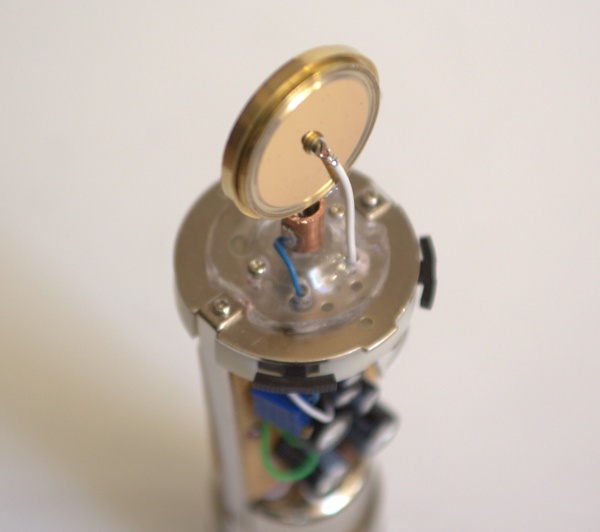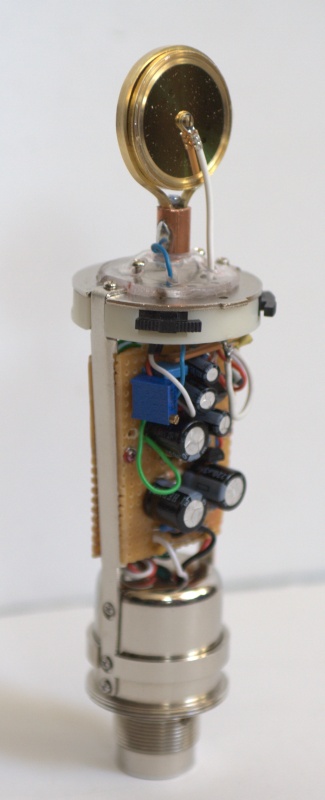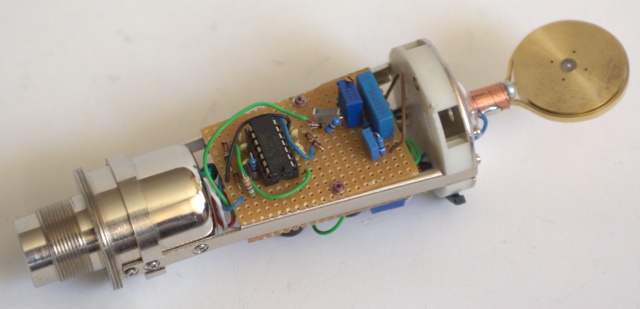I'm finally catching up with building mics out of the capsules I bought so I have an excuse to buy more capsules ;D
After my M49ish FET mic with a Dale M7 (http://www.groupdiy.com/index.php?topic=30406.0), I decided on trying the C37 style capsule I bought.
This is the capsule mount. I molded the dome out of plexiglass, which I heated over a candle. Hey, it's Christmas time

The circuit is my own design - well there's nothing really new under the sun, anymore, but it's not a copy of anything that I know of. It is an impedance balanced transformerless design with only two transistors (the transformer of the donor mic is disconnected). There are no caps in the direct audio path except for the unavoidable output lytics. The C37 capsule is about 12 dB lower in output than a M7, so it wasn't exactly easy to achieve low noise. I might start a topic in the Drawing Board section about the circuit. There may be improvements to be made, but right now, I'm quite happy with it.

There is a CMOS-based DC-DC converter board on the backside which puts out about 68V for the capsule. The mic is now as quiet as a studio mic ought to be. I have no exact figures, but I'm fairly certain it is below 18 dB-A self noise. (Which is quite a bit lower than Sony C37/C38 mics, but I have no experience with those, so maybe they are better than what the datasheets say.)

So how does the C37 style capsule sound? Well, very different from an M7. It sounds very real and unflattering; you feel a bit naked singing into it. But at the same time there is an unpretentious realism about it that few LD mics will achieve. It sounds a little bit bright-ish in the 4k range, but there's no sibilance. S- and T-sounds are very clear and undistorted. Somehow this mic makes me think of Steve Winwood. I think this is a good mic for a loud and/or forward singer and also for spoken word (if you're going for a realistic sound, not that huge commercial type of voice sound). I wouldn't use it for a crooner type of singer.
Anyway, this build gave me quite some trouble, but in the end I'm very happy with this mic. It is definitely a different "voice" in the mic cabinet. Thanks again to Dale for his capsule wizardry.
Cheers,
Andreas
After my M49ish FET mic with a Dale M7 (http://www.groupdiy.com/index.php?topic=30406.0), I decided on trying the C37 style capsule I bought.
This is the capsule mount. I molded the dome out of plexiglass, which I heated over a candle. Hey, it's Christmas time

The circuit is my own design - well there's nothing really new under the sun, anymore, but it's not a copy of anything that I know of. It is an impedance balanced transformerless design with only two transistors (the transformer of the donor mic is disconnected). There are no caps in the direct audio path except for the unavoidable output lytics. The C37 capsule is about 12 dB lower in output than a M7, so it wasn't exactly easy to achieve low noise. I might start a topic in the Drawing Board section about the circuit. There may be improvements to be made, but right now, I'm quite happy with it.

There is a CMOS-based DC-DC converter board on the backside which puts out about 68V for the capsule. The mic is now as quiet as a studio mic ought to be. I have no exact figures, but I'm fairly certain it is below 18 dB-A self noise. (Which is quite a bit lower than Sony C37/C38 mics, but I have no experience with those, so maybe they are better than what the datasheets say.)

So how does the C37 style capsule sound? Well, very different from an M7. It sounds very real and unflattering; you feel a bit naked singing into it. But at the same time there is an unpretentious realism about it that few LD mics will achieve. It sounds a little bit bright-ish in the 4k range, but there's no sibilance. S- and T-sounds are very clear and undistorted. Somehow this mic makes me think of Steve Winwood. I think this is a good mic for a loud and/or forward singer and also for spoken word (if you're going for a realistic sound, not that huge commercial type of voice sound). I wouldn't use it for a crooner type of singer.
Anyway, this build gave me quite some trouble, but in the end I'm very happy with this mic. It is definitely a different "voice" in the mic cabinet. Thanks again to Dale for his capsule wizardry.
Cheers,
Andreas


